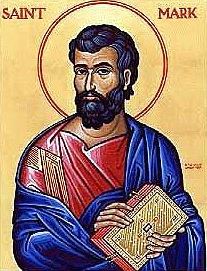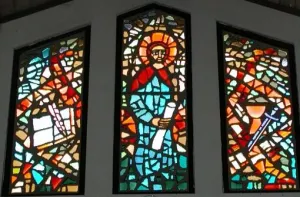 This is post number six in my ongoing series containing my reviews and thoughts on Daniel Kirk’s newest volume, A Man Attested by God: The Human Jesus of the Synoptic Gospels. Today we will start your Labor Day weekend examining Kirk’s second chapter – “Son of God as Human King.” In particular, I will focus on the Gospel of Mark, the first document Kirk discusses in this chapter. As has been my custom in these reviews, I offer a few bullet points covering his arguments along with a few comments of my own in italics.
This is post number six in my ongoing series containing my reviews and thoughts on Daniel Kirk’s newest volume, A Man Attested by God: The Human Jesus of the Synoptic Gospels. Today we will start your Labor Day weekend examining Kirk’s second chapter – “Son of God as Human King.” In particular, I will focus on the Gospel of Mark, the first document Kirk discusses in this chapter. As has been my custom in these reviews, I offer a few bullet points covering his arguments along with a few comments of my own in italics.
- The Christology of Mark needs to be read on its own terms, particularly outside of the lens of the Fourth Gospel. I would be interested in testing Kirk’s idealized human figure hypothesis on the christological claims and statements within the Gospel of John, but that will likely require another 600+ page book from him (here’s hoping).
- Kirk builds a overall persuasive argument noting the internal structure of Mark in which Jesus is proclaimed as “Son of God” in three key moments of the narrative: at his baptism, at the Transfiguration, and upon the cross by the Gentile centurion. Thematically, these three episodes share, broadly, many elements, actions, and phrases, suggesting that the writer deliberately placed them there for structural and theological reasons. Each of these episodes contain:
- a voice claiming that Jesus is the Son of God
- a reference to Elijah
- the act of ripping (heavens, cloud, temple curtain)
- a reference to the Spirit/spirit
- an associated meaning with Jesus’ death
- a key linking with Jesus’ kingship
- Mark’s Gospel opens with a YHWH quotation from Isaiah seemingly used with Jesus as “Lord” instead. However, Kirk has already demonstrated in the previous chapter that this manner of using texts from the Hebrew Bible also appears at Qumran without any hint that those persons were claiming to be YHWH himself.
- Jesus is empowered with the Spirit at his baptism. Many other human figures in the Hebrew Bible were similarly empowered. Furthermore, the voice from heaven proclaiming the sonship of Jesus, if indeed echoing language from Psalm 2, makes Jesus out to be an anointed king distinguished from and wholly subordinate unto YHWH.
- Jesus proclaims the kingdom of God as gospel and performs deeds/miracles, such as healings and exorcisms, which verify the preaching of God’s rule.
- Mark places considerable stress in regarding Jesus as the royal king of God’s kingdom, but a king whose path to kingship first involves rejection, suffering, and death. This emphasis, of course, is not initially understood by the disciples. That is why they are called the “duh-sciples” because they just dont get it. =)
- Jesus is said to one day return “in the glory of his Father” (8:38), indicating a measure of an agent invested in the glory of the one who sends him. This glory, not surprisingly, appears in the following episode’s vision of the Transfiguration. Kirk rightly notes that Dan 12:2-3 regards those who are bodily resurrected to the life of the age to come as shining in luminous glory, and this image is the appropriate way in which to understand the glowing Jesus at the Transfiguration (cf also Moses’ veiled face from God’s glory). Kirk suggests the appearance of Moses and Elijah at this event is indicative that they had been exalted to heaven. I prefer to see the Transfiguration as a vision of the resurrected (per Dan 12:2-3) glory of Jesus accompanied by Moses and Elijah, both bodily resurrected from the grave. Matthew redacts this account and has Jesus clearly stating that it is a “vision” (Matt 17:9) and the fact that the episode subsequently follows a statement about a few disciples witnessing the kingdom of God further points me in this interpretive direction. But I digress…
- Kirk draws attention to some nice parallels between Jesus at the Transfiguration and Moses ascending to the mountain:
- Both encountered God on the mountain
- Both brought three witnesses (Peter, James, John with Jesus; Aaron, Nadab, and Abihu with Moses)
- Both waited six days before ascending to the mountain
- Both come into contact with God in a cloud
- Both appear to be glorified or bearing a piece of God’s glory
- The titles “Son of God” and “Son of Man” appear to overlap and offer similar roles of rejection before exalted kingship. Furthermore, these are not thinly veiled indicators of divinity and humanity (in the sense of the later doctrine of the two natures of Christ).
- Plutarch recounts how Caesar’s death resulted in cosmic signs, particularly the sun being blocked. Since Caesar (and his successors) were widely regarded and worshiped by the imperial cult as “Son of God,” Mark’s insistence that Jesus’ death resulted in “darkness falling over the land at the sixth hour” of Good Friday indicates that Jesus is also to be regarded as “Son of God” (perhaps, in my opinion, polemically against the claims of Rome and the imperial cult).
- Fallen spirits/demons worship Jesus. Yet Kirk has already demonstrated that angels worship Adam in contemporary Jewish literature. Being worshiped does not prove that one is identified as YHWH. See also 1 Chron 29:20.
- Jesus, far from being the omniscient God of Israel, admits he does not know the day or the hour of his second coming (13:32). In stating this, Jesus differentiates himself from the angels and from the Father, the one who alone knows this information. Mark does not say that Jesus’ humanity didn’t know but that his divine side did know. No, rather only the Father knows (even the Holy Spirit is unaware, if it is to be regarded as a person distinct from the Father, which I doubt).
- “Abba” does not mean “Daddy” (cf. Rom 8:15 and Gal 4:6). It only further points to Jesus as the authentic Son of God.
- When Jesus heals the paralytic earlier in the Gospel he is met with opposers who state, “Who can forgive sins but God alone?” God has given authority to the Son of Man to forgive sins, and Jesus later gives that very same authority to the disciples (11:25). If the disciples can truly forgive sins, then they are certainly not divine (and neither is Jesus for that matter).
Mark checks out to fit the working hypothesis that Jesus of Nazareth is best understood as a Jewish idealized human figure (rather than a preexisting divine person or angel). Let me know in the comments below what you think of Kirk’s reconstruction of the Gospel of Mark. Tomorrow I plan to post on Kirk’s arguments in the Gospel of Luke regarding how he depicts Jesus as “Son of God,” so stay tuned!

